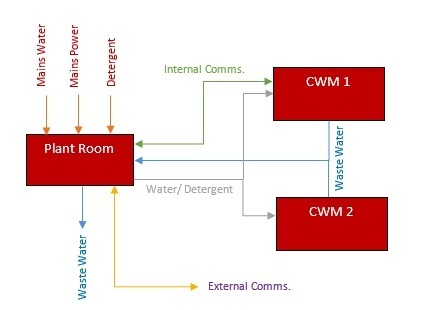Garrandale Rail has been awarded a contract to deliver a Train Carriage Wash System (CWS) for Old Oak Common Depot. To ensure optimal safety and reliability of the operating system, Wilde was asked to perform an analysis that assesses the CWS against their client’s Reliability, Availability, Maintainability and Safety (RAMS) requirements.

Business Benefits
Garrandale relied on Wilde’s expertise to successfully provide the necessary evidence and supporting data that the new CWS meets their client’s RAMS specifications. Wilde advised that these analyses should be treated as ‘live documents’, and continually updated as more information becomes available.
Company
Garrandale has extensive experience designing, manufacturing, installing and maintaining carriage wash systems, fueling stations, controlled emission toilet, lubricating and monitoring systems.
Over the past three decades Garrandale has delivered innovative solutions to the rail, engineering and chemical sectors, including simple fabrications to high specification, safety critical components for the transportation, petrochemical, oil and gas industries, both on time and within budget.
Background
The new CWS design that is to be installed at Old Oak Common Depot is similar to previous designs that are already in service across the rail network. There are two Carriage Wash Machines (CWM) that form part of the entry into the depot, washing train carriages as they enter. The lines are also used to exit trains from the depot, however the wash cycle does not occur in this instance. The two CWMs may both operate simultaneously or individually, depending on the throughput into the depot. As a train approaches it passes over a track switch that activates a wash sequence. Each carriage wash then has 5 stages to clean and rinse the train.

Figure 1: Functional Block Diagram showing connections between Carriage Wash System (Courtesy: Garrandale Rail)
Challenge
In order for Garrandale to provide evidence and supporting information that the new CWS meets their client’s specifications, Wilde were required to provide necessary performance data and input for completion of a RAMS assessment. This was achieved by performing 3 separate analyses using ReliaSoft’s Synthesis software.
- Maintenance Task Analysis (MTA) to identify repair times for planned maintenance activities
- System Reliability Assessment to calculate availability based on planned and unplanned maintenance activities
- Failure Mode and Effects Analysis to identify single point failures
Solution
- Maintenance Task Analysis (MTA)
The Maintenance Task Analysis identified the planned maintenance tasks that are expected to be performed on the system. This was performed using the maintenance manual to identify task duration and frequency. Accounting for planned maintenance only, operational availability is 99.1%; this is above the requirement of 98%.
- System Reliability Assessment
To calculate system reliability and account for unplanned maintenance, Wilde modelled failure of individual items using Reliability Block Diagrams using the system-level modelling package ReliaSoft BlockSim. Failure rate data was collected for each component in the system and represented as a ‘block’ within the diagram. These were connected based on their ‘reliability-wise’ configuration to account for redundancy in the system. This enabled the calculation of Failure Rate (FR) and Mean Time Between Failure (MTBF) values. The maintenance tasks from the MTA were considered, to calculate the Availability of the system with corrective maintenance and spare parts usage. The calculation results showed availability above the requirement of 98%.
- Failure Mode and Effects Analysis (FMEA)
To identify potential single point failures of the system, a FMEA was performed. This is a systematic bottom up approach that considers the failure mode for each component in the system, its effects and potential causes. The analysis was performed at a functional level, considering components at the level they are defined in the provided Piping & Instrument D iagram . The ’Effects’ of failure are described in a manner that aligns with a Customer symptom (e.g. Poor Wash Quality), to assist with future diagnostics of plant failures.
Two single-points of failure were identified that would result in both the Carriage Wash Machines being unavailable and one single-point of failure that would result in just one machine becoming unavailable. Other subtle failures were identified resulting either in no end effect or some degree of degraded wash, this was attributed to the large amount of redundancy within the system.

Figure 2: Top level RBD for CWS with requirement for one CWM to be operational (Courtesy: Garrandale Rail)




